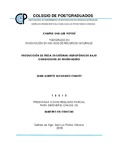| dc.contributor.advisor | García Herrera, Eduviges Javier | es_MX |
| dc.contributor.advisor | Lara Herrera, Alfredo | es_MX |
| dc.contributor.author | Alvarado Chávez, Juan Alberto | |
| dc.creator | ALVARADO CHAVEZ, JUAN ALBERTO; 770751 | |
| dc.date.accessioned | 2019-05-20T19:46:08Z | |
| dc.date.available | 2019-05-20T19:46:08Z | |
| dc.date.issued | 2018-11 | |
| dc.date.submitted | 2019 | |
| dc.identifier.citation | Alvarado Chavez, J. A. (2018). Producción de fresa en sistemas hidropónicos en condiciónes de invernadero. Salinas de Hidalgo, S. L. P.: El autor, Tesis (Maestría en Ciencias, especialista en Innovación en el Manejo de Recursos Naturales), Colegio de Postgraduados, Campus San Luis Potosí, 2018 | es_MX |
| dc.identifier.uri | http://hdl.handle.net/10521/3156 | |
| dc.description.abstract | La agricultura protegida es una tecnología que permite disminuir la presión sobre los recursos naturales, principalmente en suelo y agua. México es el tercer país productor de fresa con 3 % del volumen mundial. El cultivo tradicional de fresa en suelo no brinda las mejores condiciones para desarrollar su potencial, por lo que es posible incrementar su rendimiento hasta en 75 % con la utilización de tecnología, como la agricultura protegida y los sistemas hidropónicos. Considerando lo anterior, el objetivo del estudio fue evaluar en los sistemas hidropónicos piramidal y vertical los factores siguientes: (a) dos variedades de fresa, Festival y San Andreas, (b) dos y tres densidades de plantas y (c) tres y cuatro elevaciones, respectivamente. La distribución de los tratamientos fue bloques completos al azar con tres repeticiones en el sistema piramidal y seis repeticiones en el vertical. El análisis estadístico se realizó mediante un modelo general lineal y un procedimiento de regresión. En el sistema piramidal los factores variedad y densidad no mostraron diferencias entre los niveles ensayados. El factor elevación mostró diferencias significativas, concluyendo que la elevación alta tiene mayor número de hojas (10.5 Hojas planta-1), diámetro de la corona (2.7 cm), diámetro de fruto (1.84 cm), número de frutos (6 frutos planta¬-1), porcentaje de sólidos solubles (7 %) y rendimiento (547.6 g planta-1) que las tres elevaciones inferiores. En el sistema vertical, la variedad mostró diferencias entre tratamientos, ya que Festival tuvo mejor comportamiento vegetativo. La producción en el sistema piramidal fue de 23.5 kg m-2 y en el sistema vertical de 16 kg m-2. | es_MX |
| dc.description.abstract | ABSTRACT: Protected agriculture is a technology that allows to reduce the pressure on natural resources, mainly in soil and water. Mexico is the third producer of strawberry with 3% of the world volume. The traditional cultivation of strawberries in the soil does not provide the best conditions to develop their potential, so it is possible to increase their yield up to 75% with the use of technology, such as protected agriculture and hydroponic systems. Considering the above, the objective of the study was to evaluate the following factors in the pyramidal and vertical hydroponic systems: (a) two strawberry varieties, Festival and San Andreas, (b) two and three plant densities and (c) three and four elevations, respectively. The distribution of the treatments was completed randomly with three repetitions in the pyramidal system and six repetitions in the vertical. The statistical analysis was performed using a general linear model and a regression procedure. In the pyramid system, the factors are varied and there are no differences between the levels tested. The elevation factor showed significant differences, concluding that the highest height has greater number of leaves (10.5 leaves·plant-1), diameter of the crown (2.7 cm), fruit diameter (1.84 cm), number of fruits (6 fruits·planta-1), percentage of soluble solids (7%) and yield (547.6 g·plant-1) than the three lower elevations. In the vertical system, the variety of differences between treatments, the Festival had better vegetative behavior. The production in the pyramidal system was 23.5 kg m-2 and in the vertical system of 16 kg m-2. | es_MX |
| dc.description.sponsorship | Conacyt | es_MX |
| dc.format | pdf | es_MX |
| dc.format.extent | 1,069 Kb | es_MX |
| dc.language.iso | spa | es_MX |
| dc.publisher | El autor | es_MX |
| dc.rights | Acceso abierto | es_MX |
| dc.rights.uri | http://creativecommons.org/licenses/by-nc-nd/4.0 | es_MX |
| dc.subject | Research Subject Categories::FORESTRY, AGRICULTURAL SCIENCES and LANDSCAPE PLANNING::Plant production::Horticulture | es_MX |
| dc.subject.classification | CIENCIAS AGROPECUARIAS Y BIOTECNOLOGÍA::CIENCIAS AGRARIAS::HORTICULTURA::FRUTICULTURA | es_MX |
| dc.subject.classification | CIENCIAS AGROPECUARIAS Y BIOTECNOLOGÍA::CIENCIAS AGRARIAS::HORTICULTURA::TÉCNICAS DE CULTIVO | es_MX |
| dc.subject.other | Hidroponía | es_MX |
| dc.subject.other | Cultivo sin suelo | es_MX |
| dc.subject.other | Agricultura protegida | es_MX |
| dc.subject.other | Sistemas de producción hortícola | es_MX |
| dc.subject.other | Sustrato | es_MX |
| dc.subject.other | Horticultura | es_MX |
| dc.subject.other | IMRN | es_MX |
| dc.subject.other | Maestría | es_MX |
| dc.subject.other | Soilless culture | en |
| dc.subject.other | Protected agriculture | en |
| dc.subject.other | Agricultural production systems | es_MX |
| dc.subject.other | Substrates | en |
| dc.subject.other | Horticulture | en |
| dc.subject.other | Hydroponics | en |
| dc.title | Producción de fresa en sistemas hidropónicos bajo condiciones de invernadero | es_MX |
| dc.title.alternative | Strawberry production in hydroponic systems under greenhouse conditions | es_MX |
| dc.type | Tesis | es_MX |
| dc.type.conacyt | masterThesis | es_MX |
| dc.identificator | 6||31||3107||310704 | es_MX |
| dc.identificator | 6||31||3107||310702 | es_MX |
| dc.contributor.director | GOMEZ GONZALEZ, ADRIAN; 58409 | |
| dc.audience | generalPublic | es_MX |


